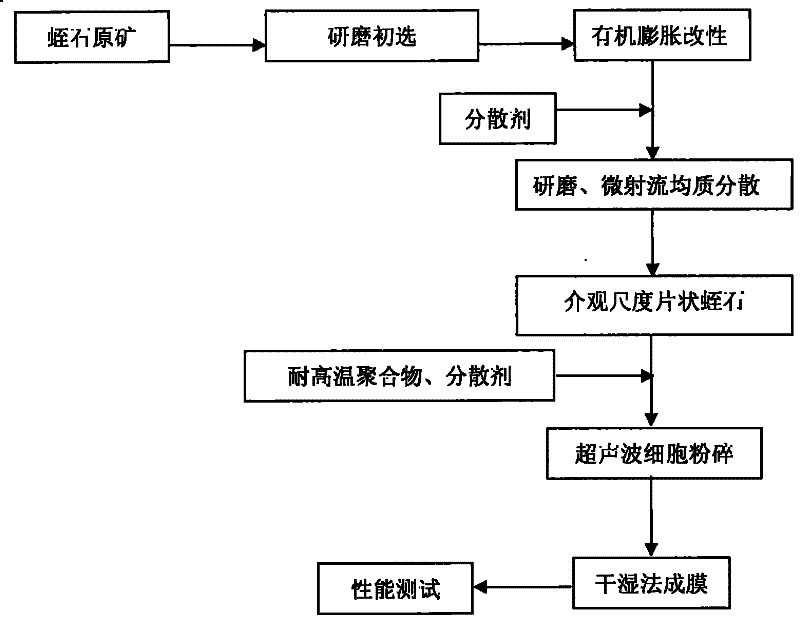Method for preparing meso-scale flaky vermiculite and heat-resistant polymer heat insulation composite membrane
A technology of high-temperature-resistant polymer and flaky vermiculite, which is applied in the field of preparation of mesoscopic-scale flaky vermiculite and high-temperature-resistant polymer heat-insulating composite film, can solve the problems of limited application and poor heat insulation performance, and achieve improved Highest operating temperature, high performance, and improved heat resistance
- Summary
- Abstract
- Description
- Claims
- Application Information
AI Technical Summary
Problems solved by technology
Method used
Image
Examples
Embodiment 1
[0025] see figure 1 The present invention can be divided into following steps:
[0026] Step 1. Use zirconia balls with a diameter of 2 to 3 mm to grind the raw vermiculite in a sand mill for 8 hours, then screen out the vermiculite with a particle size of less than 10 μm, and then dry it naturally;
[0027] Step 2. Soak the vermiculite obtained in step 1 in secondary distilled water, add 4 times the amount of dodecyltrimethylammonium chloride for cation exchange, and stir for 6 hours at a temperature of 80°C. The screened vermiculite is organically expanded and modified;
[0028] Step 3, repeatedly washing the vermiculite obtained by step 2 with deionized water until there is no Br - , Cl - Exist, then dry naturally;
[0029] Step 4, taking the weight of the vermiculite obtained in step 3 as 100%, soaking it in 20 times of double distilled water, and then adding 20% of sodium lauryl sulfate;
[0030] Step 5, use zirconia balls with a diameter of 1 mm to grind the vermi...
Embodiment 2
[0036] Step 1, grind the raw vermiculite ore with a basket mill for 100 hours, then screen out the vermiculite with a particle size less than 10um, and then dry it naturally;
[0037] Step 2, soak the vermiculite obtained in step 1 in double distilled water, add cetyltrimethylammonium bromide of 8 times the amount of cation exchange, and stir the reaction for 100h at a temperature of 50°C. The screened vermiculite is organically expanded and modified;
[0038] Step 3, repeatedly washing the vermiculite obtained by step 2 with deionized water until there is no Br - , Cl - Exist, then dry naturally;
[0039] Step 4, taking the weight of the vermiculite obtained in step 3 as 100%, soaking it in 10 times double distilled water, and then adding dispersant FZ100%;
[0040] Step 5, grind the vermiculite aqueous dispersion system obtained by step 4 with a basket mill for 2 hours, then process it 50 times with high-pressure micro-jet homogenization equipment, centrifuge, and vacuum-...
Embodiment 3
[0046] Step 1. Grind the raw vermiculite with a pulverizer for 2 hours, then screen out the vermiculite with a particle size of less than 10um, and then dry it naturally;
[0047] Step 2. Soak the vermiculite obtained in step 1 in double distilled water, add behenyltrimethylammonium chloride of 1 times the amount of cation exchange, and stir the reaction for 12 hours at a temperature of 80°C. Carry out organic expansion modification to the screened vermiculite;
[0048] Step 3, repeatedly washing the vermiculite obtained by step 2 with deionized water until there is no Br - , Cl - exist, then dry naturally;
[0049] Step 4, taking the vermiculite weight obtained by step 3 as 100%, dipping in 30 times of twice distilled water, then adding 30% of sodium hexametaphosphate;
[0050] Step 5. Grind the vermiculite obtained in step 4 with a pulverizer for 100 hours, then process it once with high-pressure micro-jet homogenization equipment, centrifuge, and vacuum-dry for 48 hours ...
PUM
| Property | Measurement | Unit |
|---|---|---|
| particle diameter | aaaaa | aaaaa |
| diameter | aaaaa | aaaaa |
Abstract
Description
Claims
Application Information
 Login to View More
Login to View More - R&D
- Intellectual Property
- Life Sciences
- Materials
- Tech Scout
- Unparalleled Data Quality
- Higher Quality Content
- 60% Fewer Hallucinations
Browse by: Latest US Patents, China's latest patents, Technical Efficacy Thesaurus, Application Domain, Technology Topic, Popular Technical Reports.
© 2025 PatSnap. All rights reserved.Legal|Privacy policy|Modern Slavery Act Transparency Statement|Sitemap|About US| Contact US: help@patsnap.com



